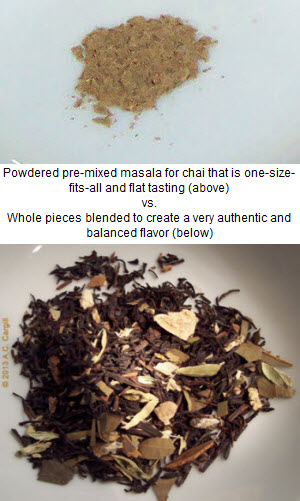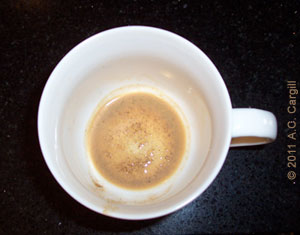 |
Just as there is a debate about which is better for foods (store bought versus homemade), so there is a debate over masala chai (spiced tea). That is, which is better — a nice orthodox tea with real cardamom seeds, pieces of bay leaves and ginger, bits of cinnamon bark, etc., or the ground-to-a-powder stuff that’s sat around awhile in the warehouse and then the store and then on your shelf at home? The answer to this debate is simple: it depends on who's making it. I have had both with very mixed results. Plus, there are versions in-between, muddling things even more. Basically, it breaks down as follows:
Homemade Masala Chai
The homemade version of masala chai starts with your favorite tea. It could range from some of the bagged tea brands or a loose tea (either orthodox or CTC). Then, you can spice it up either with a powder mix from the store (shown in the photo on the right) or go all the way and add in the full spices from you cupboard. With the powdered mix you get whatever is in it, so you would need to find one that has the right balance of flavors that you prefer, or you’ll need to add in a bit extra of the things it lacks (you might like a dash more black pepper or more of that ground cinnamon, for example). If instead you add the various spices individually to the tea yourself, you can go heavier on the cardamom or lighter, heavier on the cinnamon or lighter, and so on until you get it just right.
Pre-mixed Masala Chai
Pre-mixed masala chai not only has all the spices, etc., but also the dry tea already pre-mixed together, so again you have to choose carefully, selecting one with the tea type you like (most use a black tea but some use green tea and even oolong) and the balance of flavorings you prefer. These pre-mixed masala chais vary widely, ranging from instant powdered kinds that emphasize one flavor over another to the kinds that start with orthodox tea and add in whole spices, not powders. This latter kind are the closest to homemade, especially if you get them from a vendor who really knows how to add the flavors together well.
Both types of pre-mixed offer something over homemade: consistent flavor. The instant kind also offers more convenience, possibly making up for what it lacks in taste. However, they both also have drawbacks.

Residue at the bottom of the cup from an |
The biggest problem I have with the instant powdered masala chais is the residue at the bottom of the cup. If you’re the kind of person who won’t dunk your biscuit/biscotti/cookie or whatever in your tea because you hate the crumbs that have broken off and sunk to the bottom of the teacup, this residue will drive you a bit nutty. It sure does me. The other issue is … well, they’re powder … and tend to have a flavor that is somewhat powdery, not bright and fresh.
My most recent foray into the pre-mixed masala chai was the one from Lochan Tea, Ltd., that used those whole pieces of spices and herbs, and for me it was the perfect one.
The key is getting the mix of flavorings just right. Too many tea vendors who create a pre-mixed spiced tea go way overboard on the cinnamon, and I mean WAY overboard, as if they were trying to drown out the other flavors, including the taste of the tea. Or maybe they think their customers’ tastebuds are so dulled as to need that strong blast of flavor for anything to register. Quite frequently, the latter is very true. People get so used to strong flavors that they can’t perceive more subtle tastes. Cinnamon is a prime example. But so are ginger and cardamom. All three are flavors I love, but keeping them in balance can be tricky. This chai not only avoids that “cinnamon-itis” but also stays true to an Indian flavor palate.

A cup of pure joy |
Why the Difference Matters
The issue here is authenticity. Just as we Westerners have been taught that the foods we eat at Chinese restaurants are authentic, so it goes with Indian foods. Things like lamb vindaloo are actually from the former Portuguese colony of Goa. Tikka Masala is a version of Tandoori chicken with a spicy sauce added, developed to satisfy British taste (they thought the chicken was too dry otherwise) when Indian restaurants started opening up in the UK. Thus the importance to me personally of getting things that are truly authentic to a particular culture and its customs.
While as always I advocate that you follow your own personal taste, I also advocate that you try new things and expand your horizons.
The choice, of course, is yours.
